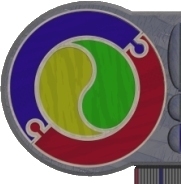Computer Systems eXercises #5
Architectures and Data Communication - Solutions
1.
1. All devices share the central DATABUS, and are allowed access to it only when it is
their 'turn' - thus throughput of information can be slowed by inability to continually
load data on to the bus
2. wider databus (more bits per turn), faster timetable, extra busses (VESA Local
bus is an example of this), prioritize users of the bus
3. the expense of wiring everything to everything would be prohibitive
2.
parallel communication allows 1 wire for each of the bits in a byte - the
'entire byte travels together' down the wire bundle. Serial communication
provides 1 wire for transport, so the bits must be sent down the wire ONE
AFTER THE OTHER, along with sufficient control bits to ensure the reciever
gets all of the bits
3.
databus transports data (both operands (= numbers) and opcodes (=instructions)),
the control bus sends the signals necessary to 'warn' the recieving device that
data is 'on the way', and that it has finished sending.
4.
1. speed (measured in bits/sec), parity, databits, start bits, stop bits, rest bits, ....
2. if matching protocol decisions are not reached, meaningful data exchange cannot proceed
3. parity relys on BIT SUM's to be either ODD or EVEN - it is a primitive
error detection scheme and is prone to 2-bit erros (which it cannot detect)
5.
1. 10 seconds x 14.4Kb per sec = 10 x 14400 bits = 144000 bits recieved
1 character = 8 data + 1 start, 3 stop + 2 rest = 14 bits
144000 bits = 102857 characters (and a few stray bits)
2. 1Mb of text = 1048576 characters x 14 bits per char
= 14680064 bits to send at 14.4Kb/s
= 1019.45 seconds
= 16 minutes (approx) at least
3. 'noise' on the line, variances in signal bearing capabilities on the line, readiness of the reciever...
6.
1. it would appear that each of the bytes arriving arrived with an ODD bit sum - so
it would appear that they arrived correctly
2. NO - as any number of 2-bit errors could have occurred (although this is most unlikely)
7.
1. 65 42 8 x y
1 2 3 4 5
initially x = y = 0; A = B = 0
1 A = 0+65 = 65 B = 0+65
2 A = 65 + 42 = 107 B = 65 + 107 = 172
3 A = 107 + 8 = 115 B = 172 + 115 = 287 = 32
4 A = 115 + 0 = 115 B = 32 + 115 = 147
5 A = 115 + 0 = 115 B = 147 + 115 = 263 = 7
X = -B + A = -7 + 117 = 110
Y = B - 2A = 7 - 2x115 = 7 - 230 = -223 = 2
SENT BYTESTREAM = 65 42 8 110 2
2. you can do this - so long as the calculation evaluating A and/or B arrives at 0
then the transmission occured without error
8.
1. UTP (Unshielded twisted pair = telephone cable)
2. UTP (compressed and low resolution) or COAX
3. UTP
4. voice - low integrity, video low integrity, ATM transactions HIGH integrity
9.
if we were to choose 0 volts on the line as a 0 then we would be unable to
differentiate whether we were actually connected to the other device - a 0 is
usually just above 0 volts, so we can tell when there has been a disconnection
(ie. 0 volts on the line = no connection)
|


